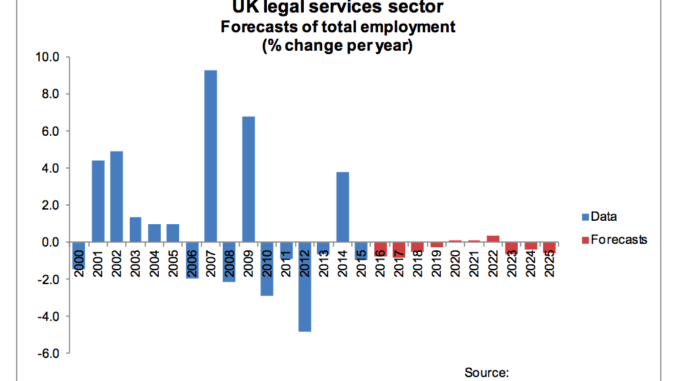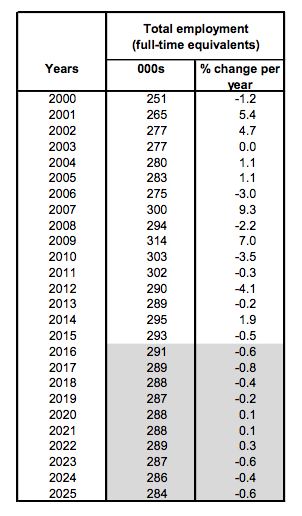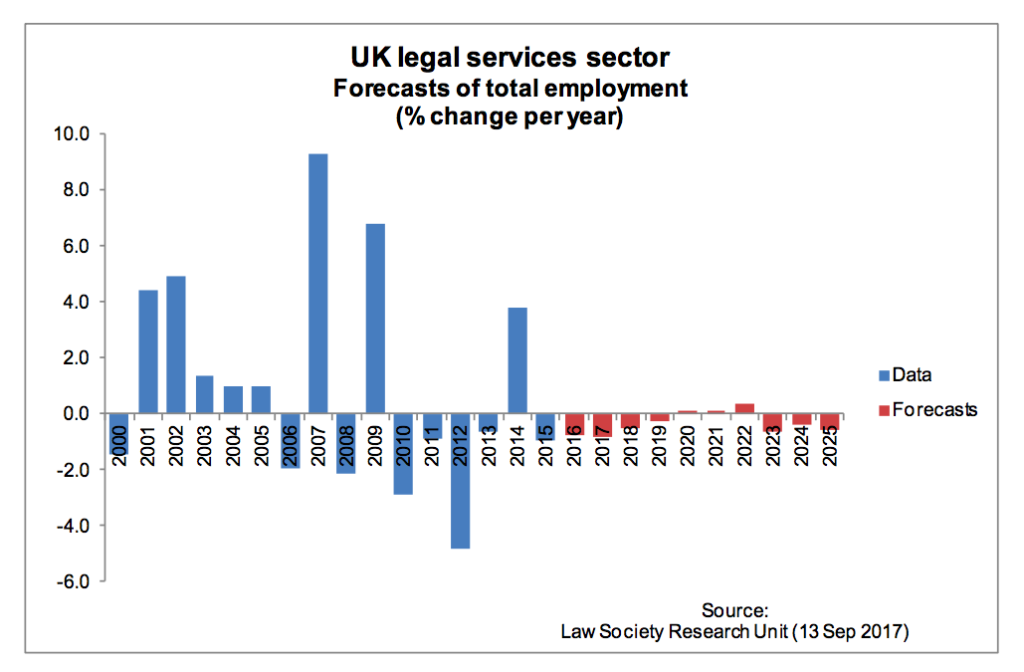
The Law Society of England & Wales has had a punt on what the future will look like by 2025, taking into account the rise of legal AI and automation inside law firms. And the answers are both reasonable and surprising.
In a nutshell the answer to what the long-term future will look like is as follows:
- Overall the UK legal market will grow in financial terms.
- The total number of lawyers and staff will decrease, despite this revenue growth.
- This decrease will be driven in part by AI and automation of tasks.
- And….in fact, the market for law firm staff has peaked already, back in 2009.
And so there it is. It seems to be a very reasonable future prediction as well as an intriguing historical analysis, both at the same time.
Artificial Lawyer would support the overall thesis. This is because legal demand has always tended to increase as a longer-term trend in Western nations. Regulation always increases, so too the complexity of the legal world. Globalisation also tends to drive legal work to the main legal and financial centres of the world, of which London is one.
Hence, although home ownership, which is a key driver of consumer level legal needs, will fluctuate in the years ahead, the overall picture is of increasing demand for legal input, at least among larger commercial enterprises (though how much they will bring in-house in the future remains to be seen).
The next point is perhaps the one readers here will be most focused on: will tech drive jobs out of the legal sector? The Law Society and its Senior Economist, Keith Blakemore, believe this is the case.
But how much change will take place? Are we looking at decimation, or more? The Law Society‘s conclusion is both less dramatic, but perhaps also more credible than many others’ predictions.
Rather than predicting the ‘end of lawyers’ they simply suggest that hiring levels, in net terms, will grind to a halt. Moreover, the legal industry in what is the world’s second largest market for this stuff, has already peaked in terms of staffing. Though, it may also be the case that law firms and inhouse teams now seek to recruit for new types of roles, such as legal engineers, but that won’t be sufficient to make up the losses elsewhere in the industry.
The data presented suggests that we peaked in terms of total staffing back in 2009, just after the financial crisis. However, this figure includes all those involved in the production of ‘legal goods’, lawyers, PAs, BD people, ‘keep the lights on’ staff and so on. It also covers all levels of legal work, from the star M&A partners in the City to a paralegal in a ‘legal factory’ in Birmingham handling the basic parts of conveyancing work.

That is to say, the feared ‘legal robot apocalypse’ isn’t really foretold, and instead process level jobs have already started to disappear due to far simpler forms of technology.
The long term prognostication is that by 2025 total E&W legal sector employment will be 284,000, even though the total size of the legal market will have grown by a couple of percentage points each year from now until then.

So, what does this all mean? The first point is that although many readers here will work in the ‘Big Law’ world, the reality is that a huge chunk of legal work is already at the ‘process’ end of the market, e.g. basic property work and low value claims handling. These lower value segments employ 10,000s of people across the country. Even small improvements in technology will understandably have an impact. You don’t need AI to make an impact on such a manual and volume segment. Though, adding higher levels of tech will certainly mop up even more of these lower skilled jobs in the future.
Meanwhile, for the larger commercial firms, which between them also retain 10,000s of lawyers and other staff, advances in tech have already driven many PAs out of their jobs. And that is just the beginning.
That said, one curious aspect that Artificial Lawyer has observed is that the number of paralegals appears to be increasing and looks likely to increase in the short term as demand for large scale review projects increases. This is despite advances in AI for doc review. However, it seems logical that we will eventually reach a maximum level here too in the coming years and this group will also face staffing cuts as AI is more fully implemented across firms for such work.
In economic terms what does this mean for large law firms? If revenues increase overall due to demand always edging up, at least among larger businesses in a globalising world, while total staffing decreases due to AI and automation then….unless clients really push back hard on fees, or salaries for associates spiral even further out of control, then the relatively small group of equity partners at the top look likely to be even richer in the future.
One could add that the total cost of AI tools may also cut into the bottom line. But, if one looks at most software, in the long term it tends to drop in relative cost, then set itself on a course of incremental increase. I.e. first it’s very expensive as markets are small, markets adopt it and prices plummet, then suppliers start to yank up the prices each year because the market is hooked. We’re still in the early adopter moment.
So, overall, the future remains a complex place. However, historical facts we can at least be sure of, and the following really is something we should all remember when talking about the future:
The English legal market PEAKED in 2009, in terms of overall employment.
In which case, the feared changes to the legal order that we have lived with for decades has in fact already begun. We just didn’t notice it. And there is plenty more change to come.